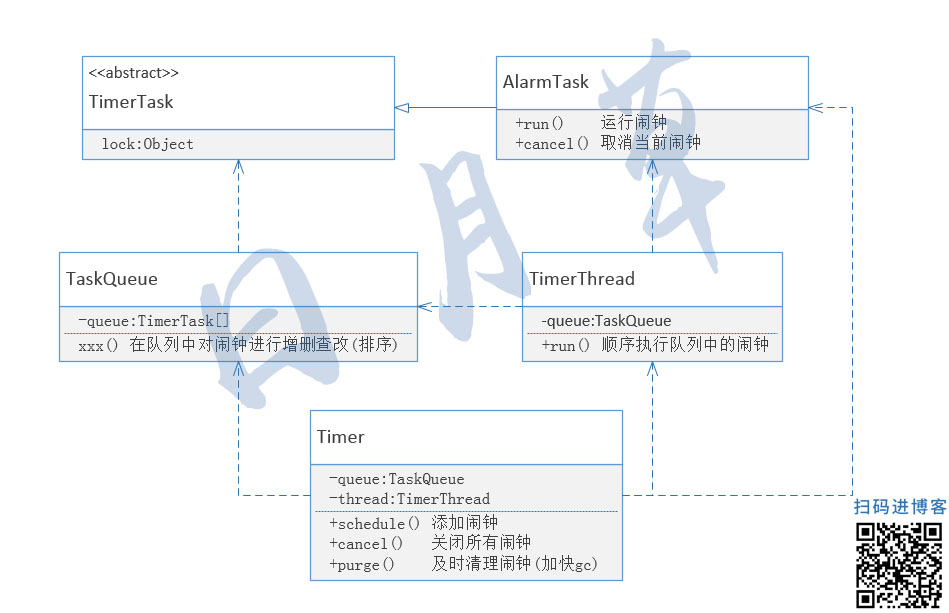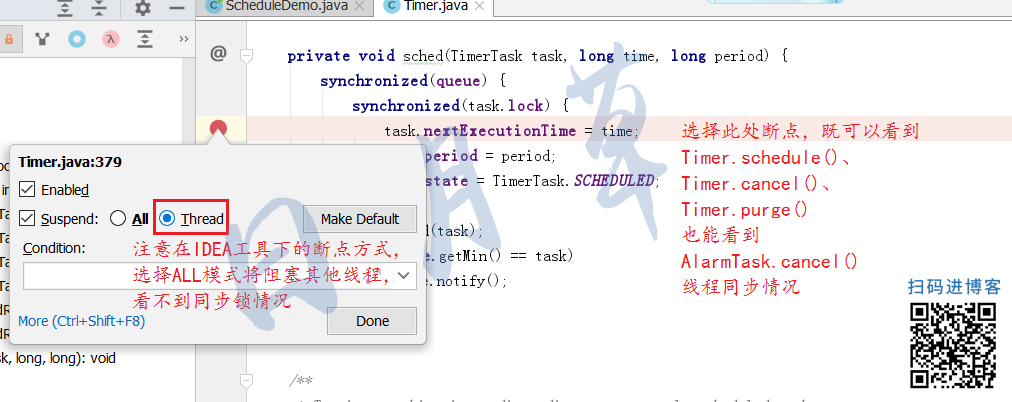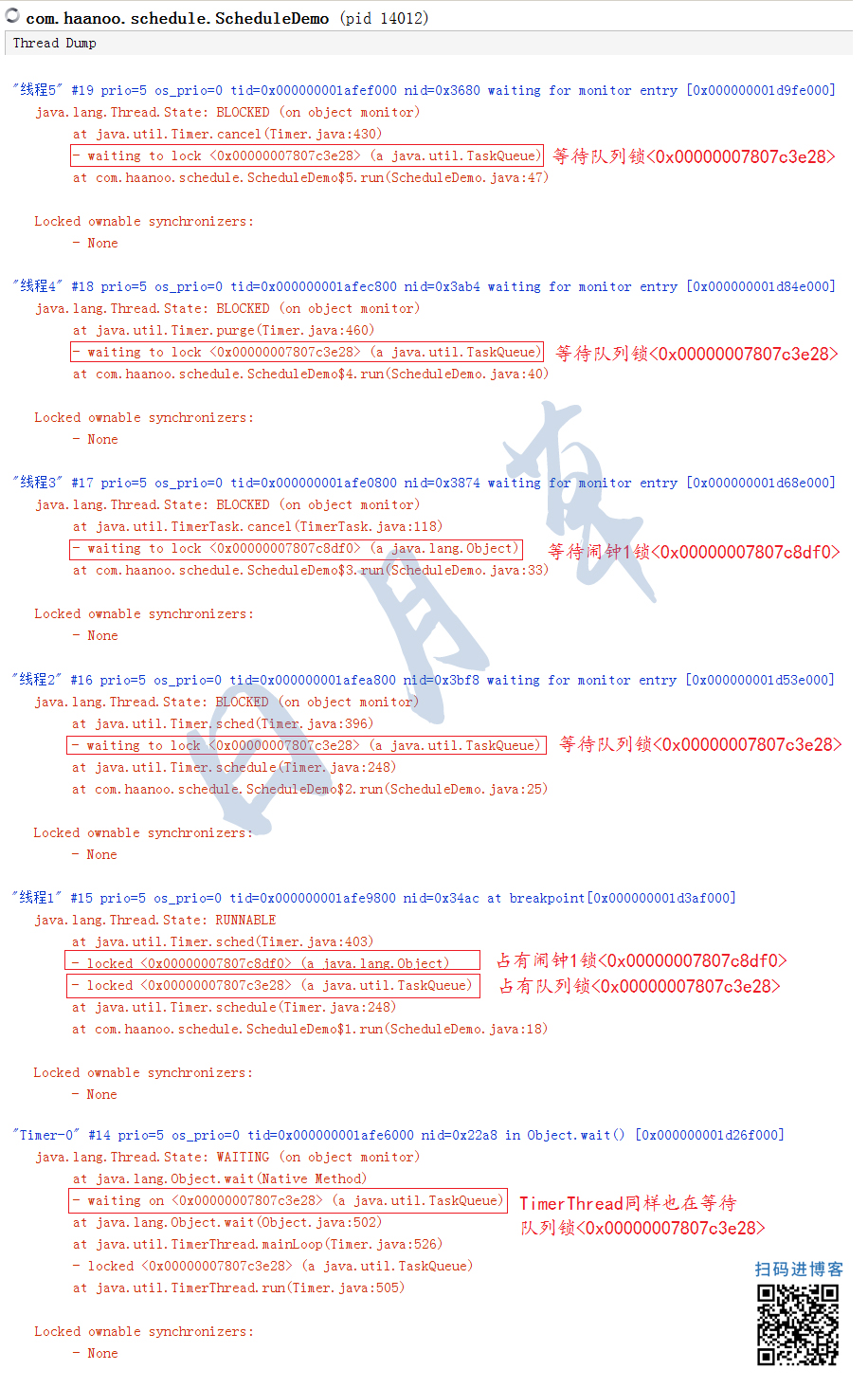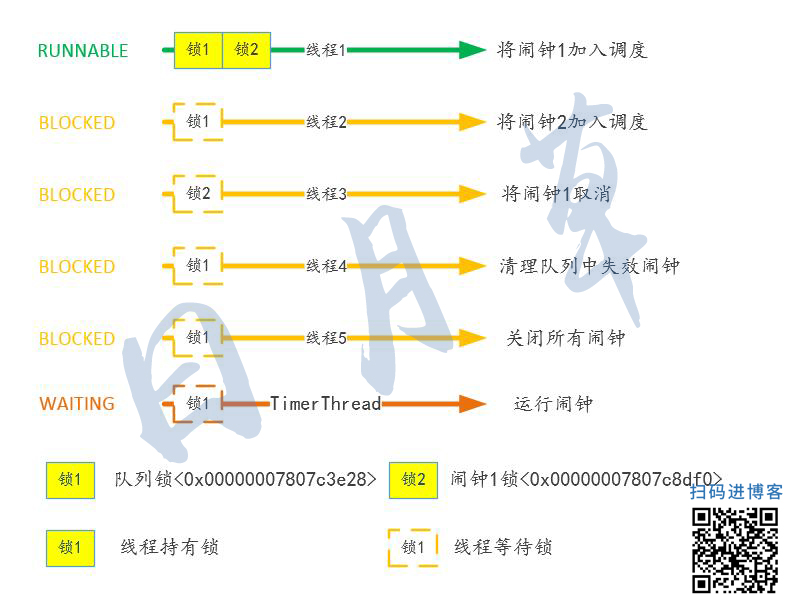上一节通过一个小例子分析了Timer运行过程,牵涉的执行线程虽然只有两个,但实际场景会比上面复杂一些。
首先通过一张简单类图(只列出简单的依赖关系)看一下Timer暴露的接口。
为了演示Timer所暴露的接口,下面举一个极端的例子(每一个接口方法面向单独的执行线程),照样以闹钟为例(源码只列出关键部分,下同)。
public class ScheduleDemo {
public static void main(String[] args) throws Exception {
AlarmTask alarm1 = new AlarmTask("闹钟1");
AlarmTask alarm2 = new AlarmTask("闹钟2");
new Thread("线程1"){
public void run() {
log.info("["+Thread.currentThread().getName()+"]调度闹钟1");
timer.schedule(alarm1,delay,period);
}
}.start();
new Thread("线程2"){
public void run() {
log.info("["+Thread.currentThread().getName()+"]调度闹钟2");
timer.schedule(alarm2,delay,period);
}
}.start();
Thread.sleep(1500);
new Thread("线程3"){
public void run() {
log.info("["+Thread.currentThread().getName()+"]取消闹钟2");
alarm2.cancel();
}
}.start();
new Thread("线程4"){
public void run() {
log.info("["+Thread.currentThread().getName()+"]清理无用闹钟");
timer.purge();
}
}.start();
new Thread("线程5"){
public void run() {
log.info("["+Thread.currentThread().getName()+"]关闭所有闹钟");
timer.cancel();
}
}.start();
}
/**
* 模拟闹钟
*/
static class AlarmTask extends TimerTask{
String name ;
public AlarmTask(String name){
this.name=name;
}
public void run() {
log.info("["+Thread.currentThread().getName()+"]-["+name+"]嘀。。。");
Thread.sleep(1000); //模拟闹钟执行时间
}
}
}执行结果
[线程2]调度闹钟2
[线程1]调度闹钟1
[Timer-0]-[闹钟2]嘀。。。
[线程3]取消闹钟2
[线程4]清理无用闹钟
[线程5]关闭所有闹钟 下面我们依次查看一下每个接口方法的源码。
1. 查看Timer.sched()源码
public void schedule(TimerTask task, long delay, long period) {
sched(task, System.currentTimeMillis()+delay, -period);
}
private void sched(TimerTask task, long time, long period) {
// 如果period无限大,保证其在一个合理的范围内
if (Math.abs(period) > (Long.MAX_VALUE >> 1))
period >>= 1;
// 加queue锁,保证队列操作的线程安全
synchronized(queue) {
// 加lock锁,保证任务状态的一致性(多线程环境下)
synchronized(task.lock) {
task.nextExecutionTime = time;
task.period = period;
task.state = TimerTask.SCHEDULED;
}
// 将任务加入队列实现排序
queue.add(task);
if (queue.getMin() == task)
queue.notify();
}
} 其中queue.add(task在)将任务加入队列的同时实现了内部排序。

void add(TimerTask task) {
// 队列不足时,以两倍容量扩增
if (size + 1 == queue.length)
// 从性能上要快于new一个数组的效率
queue = Arrays.copyOf(queue, 2 * queue.length);
queue[++size] = task;
// 利用二分查找算法实现任务排序
fixUp(size);
}
private void fixUp(int k) {
while (k > 1) {
int j = k >> 1;
if (queue[j].nextExecutionTime <= queue[k].nextExecutionTime)
break;
TimerTask tmp = queue[j]; queue[j] = queue[k]; queue[k] = tmp;
k = j;
}
} 从方法sched()可以看到,该方法一方面持有queue锁,用来维护队列排序的线程安全;一方面持有lock锁,用来维护任务状态的线程安全。
2. 查看TimerTask.cancel()源码
public abstract class TimerTask implements Runnable {
final Object lock = new Object();
public boolean cancel() {
synchronized(lock) {
boolean result = (state == SCHEDULED);
state = CANCELLED;
return result;
}
}对于任务的取消操作,只是简单的修改一下任务状态,中途也只占有一个lock锁!接着看一下执行任务的线程逻辑。
class TimerThread extends Thread {
private TaskQueue queue;
public void run() {
mainLoop();
}
private void mainLoop() {
while (true) {
synchronized(queue) {
while (queue.isEmpty() && newTasksMayBeScheduled)
queue.wait();
task = queue.getMin();
// 此处加task锁,防止其他线程同时调用task.cancel()
synchronized(task.lock) {
// ...维护闹钟状态
}
}
if (!taskFired) // 时间未到
queue.wait(executionTime - currentTime);
}
if (taskFired)
// 执行闹钟时,没有保持任何锁
task.run();
}
}可以看到当TimerThead真正执行闹钟时,是没有持锁的,所以当闹钟正在运行的时候AlarmTask.cancel()对其是不起作用的,换言之,只能取消下一次将要执行的闹钟。
3. 查看Timer.purge()源码
public class Timer {
private final TaskQueue queue = new TaskQueue();
// 保证被取消的task能及时进行垃圾回收
public int purge() {
int result = 0;
synchronized(queue) {
for (int i = queue.size(); i > 0; i--) {
if (queue.get(i).state == TimerTask.CANCELLED) {
queue.quickRemove(i);
result++;
}
}
if (result != 0)
// 重新整理队列中有效的任务
queue.heapify();
}
return result;
} 进一步查看queue.quickRemove(i)和queue.heapify()。
class TaskQueue {
void quickRemove(int i) {
queue[i] = queue[size];
queue[size--] = null; //清除无效任务,防止内存泄漏
}
private void fixDown(int k) {
int j;
while ((j = k << 1) <= size && j > 0) {
if (j < size &&
queue[j].nextExecutionTime > queue[j+1].nextExecutionTime)
j++; // j indexes smallest kid
if (queue[k].nextExecutionTime <= queue[j].nextExecutionTime)
break;
TimerTask tmp = queue[j]; queue[j] = queue[k]; queue[k] = tmp;
k = j;
}
}
void heapify() {
for (int i = size/2; i >= 1; i--)
fixDown(i);
} 可以看到Timer.purge()在持有queue锁时主要做两件事
1.及时清除队列中无效的闹钟防止内存泄漏。
2.重新规整队列中闹钟。
4. 最后看一下Timer.cancel()源码
public class Timer {
private final TaskQueue queue = new TaskQueue();
private final TimerThread thread = new TimerThread(queue);
public void cancel() {
synchronized(queue) {
thread.newTasksMayBeScheduled = false;
queue.clear();
//防止队列为空的情况下,TimerThead无限等待
queue.notify();
}
} 该方法在清除所有闹钟的同时,与TimerThread发生了一次线程通信——唤醒TimerThread并让其永久退出。
private void mainLoop() {
while (true) {
synchronized(queue) {
while (queue.isEmpty() && newTasksMayBeScheduled)
queue.wait();
if (queue.isEmpty())
break; // TimerThread永久退出
queue.wait(executionTime - currentTime);
}
}
} 以上是整个过程的静态分析,现在捕捉一个线程快照进行动态分析。为了dump一个特定时刻的线程快照,现在在Timer.sched()打一个断点(注意断点的方式与位置)。

以debug模式运行下面的例子。
public class ScheduleDemo {
public static void main(String[] args) throws Exception {
AlarmTask alarm1 = new AlarmTask("闹钟1");
AlarmTask alarm2 = new AlarmTask("闹钟2");
new Thread("线程1"){
public void run() {
log.info("["+Thread.currentThread().getName()+"]调度闹钟1");
timer.schedule(alarm1,delay,period);
}
}.start();
new Thread("线程2"){
public void run() {
log.info("["+Thread.currentThread().getName()+"]调度闹钟2");
timer.schedule(alarm2,delay,period);
}
}.start();
Thread.sleep(1500);
new Thread("线程3"){
public void run() {
log.info("["+Thread.currentThread().getName()+"]取消闹钟2");
alarm2.cancel();
}
}.start();
new Thread("线程4"){
public void run() {
log.info("["+Thread.currentThread().getName()+"]清理无用闹钟");
timer.purge();
}
}.start();
new Thread("线程5"){
public void run() {
log.info("["+Thread.currentThread().getName()+"]关闭所有闹钟");
timer.cancel();
}
}.start();
}
/**
* 模拟闹钟
*/
static class AlarmTask extends TimerTask{
String name ;
public AlarmTask(String name){
this.name=name;
}
public void run() {
log.info("["+Thread.currentThread().getName()+"]-["+name+"]嘀。。。");
Thread.sleep(1000); //模拟闹钟执行时间
}
}
}下图是visualVM工具dump出的线程快照(断点处)

通过上面的快照可以看到,当“线程1“(持有两把锁)处于RUNNABLE状态时,”线程2“、“线程3”、“线程4”、“线程5”都处于BLOCKED状态。需要注意的是,因为TimerThread的时间未到,暂时处于WATING状态(等待唤醒)。
下面是一个简单的形象图

总结:Timer为了保证线程安全,使用了大量的锁机制,整体上对CPU的利用率不高。